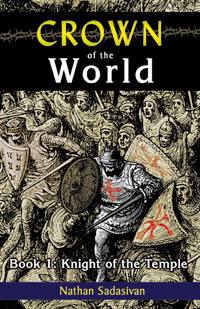
P.O. Box 1333
Merchantville NJ 08109, USA
Email: info@arxpub.com
 |
Arx
Publishing,
LLC P.O. Box 1333 Merchantville NJ 08109, USA Email: info@arxpub.com |
|
|
|
||
 Thanks to Professor Joseph Pearce for allowing us to post this excellent review of
Thanks to Professor Joseph Pearce for allowing us to post this excellent review of
Crown of the World, Book 1: Knight of the Temple from ...
Saint Austin Review
The premier international journal of Catholic culture, literature and ideas
Click here for more information about Saint Austin Review
NEWS & REVIEWS — July/August 2010 issue
Review by Phillip Campbell III
Knight of the Temple by Nathan Sadasivan is the first installment in the “Crown of the World” series, a trilogy set in late twelfth-century Palestine during the waning years of the Latin Kingdom of Jerusalem. One of the most remarkable things about this extraordinary work of historical fiction is that the author, Nathan Sadasivan, wrote the book when he was only fifteen years old. Despite this, the book is anything but juvenile; its characters and plot display complexity and depth seldom seen in many seasoned authors. Knight of the Temple is Sadasivan’s first published work, but we should probably accustom ourselves to hearing this author’s name a lot more in the future, once we have learned to pronounce it that is. It’s best to say it a few times. Sadasivan. Sadasivan.
Knight of the Temple is written in a style of historical fiction that was prevalent in American Catholic literature several decades ago and follows in the footsteps of such Catholic classics as The Outlaws of Ravenhurst and the novels of Louis de Wohl, but with greater intensity. Sadasivan’s book does an admirable job of creating a believable setting and plot, with sequences that take us from the Nile Delta in Egypt to the streets of Antioch to the Temple Mount of Jerusalem itself. The story revolves around Godfrey of Montferrat, a young Templar who struggles to do the will of God in an increasingly hostile and confusing set of circumstances. With the exception of Godfrey, almost all of the characters in the book are historical figures. The events it depicts are likewise historical, making Knight of the Temple a work of history besides being a work of fiction. Sadasivan manages to work the plot and the characters together in such a way as to achieve something truly rare: historical fiction that is faithful to history while remaining engaging and dramatic.
The depth of the book comes from its plot, which is actually three closely related plots coming together in the person of the principal protagonist. The literal plot concerns the desperate attempts of the Latin crusader kingdoms founded after the First Crusade to maintain a Catholic presence in the Holy Land amidst a rising Muslim backlash intent on driving them into the sea. All of the actions of Godfrey and the other characters revolve around this central drama, and most of the action takes place in the tumultuous years of the 1160s and 1170s leading up to the rise of Saladin and the disastrous defeat of the crusader armies at the Battle of the Horns of Hattin in 1187.
On a deeper level, the plot is also about the dilemma of duty versus personal happiness. Each of the main characters is conflicted by competing loyalties, usually framed in the context of duty to the kingdom or Church set against the desire for personal pleasure and gratification. The main character, Godfrey, finds himself torn between his duty to the Templars and an old love interest; another central character, Joscelin de Courtenay, treads a very difficult path in attempting to reconcile the loyalty owed to the office of the king with his private feelings of disgust towards the person of the king. In these varying dilemmas the reader is led to contemplate the demands that duty sometimes places upon us and shows us the ups and downs that inevitably come with carrying it out in spite of all temptations and obstacles.
Finally, on the most intimate level, the novel is about discerning one’s vocation in life. This is exemplified in Godfrey, who struggles with his monastic vows, sometimes aspiring to saintliness, sometimes questioning his entire vocation in moments of despair. Though Godfrey is a thoroughly medieval man, the questions he poses to himself throughout the book are the same questions that all men at all times have asked. This is at the heart of the novel’s very universal appeal. Thus it is not simply the vocation of one man that the novel addresses, but man’s universal desire to find purpose in his actions. Why take a vow of celibacy over marriage? How do we live the good life? In what does happiness consist? The novel is awash with these questions of purpose and identity with which the characters grapple in the face of external obstacles and inherent human weaknesses. If one word could encapsulate the whole novel it would be “struggle”, and it is on this level that it is most satisfying. Although there is little truly negative that can be said about this fine first novel, there are some very minute historical errors that nobody but a history major is likely to catch. The characters also tend to drift from time to time into philosophic or theological discourses that are quite unbelievable in the mouths of twelfth-century Norman knights, in particular a discussion between Godfrey and a Byzantine prince that sounds like something right out of G. K. Chesterton’s The Everlasting Man. Yet even this is not an unqualified negative; there is seldom a time when a Chestertonian discourse is not welcome, and the fact that putting it in the mouth of a Norman knight may be bad history does not mean it isn’t good philosophy.
Its minor weaknesses notwithstanding, Knight of the Temple is a really excellent work, fraught with tension, that hooks us for part two.
Phillip Campbell III holds a BA in European History from Ave Maria University and is currently pursuing studies in education at Madonna University in Livonia, MI. He resides in Howell, MI. with his wife and three children. Phillip is also the author of the novel, Tale of Manaeth.
Title: Crown of the World—Book 1: Knight of the Temple
Author: Nathan Sadasivan Page Count: 296 Release Date: June 2009
ISBN: 978-1-889758-92-3 Binding: Paperback Retail Price: $16.95
Publisher: Arx Publishing, LLC, PO Box 1333, Merchantville NJ 08109, USA
Phone: (856) 486-1310 • Fax: (856) 665-0170 • info@arxpub.com • www.arxpub.com
About Saint Austin Review
The St. Austin Review (StAR) is the premier international journal of Catholic culture, literature, and ideas. In its pages, printed every two months, some of the brightest and most vigorous minds around meet to explore the people, ideas, movements, and events that shape and misshape our world. Contributors to StAR are poets, philosophers, artists, theologians, historians, and journalists, together giving StAR the breadth and depth necessary for its “unique and worthwhile project” (Karl Keating). Joining editors Joseph Pearce (Literary Converts, Wisdom and Innocence) and Robert Asch, they include: Pope Benedict XVI, Fr. James Schall, SJ, Scott Hahn, Peter Kreeft, Fr. Aidan Nichols, OP, Ralph McInerny, Michael O’Brien, Alice von Hildebrand, Thomas Howard, Fr. Benedict Groeschel, CFR, and many, many more.
For more information or to subscribe, please visit: www.staustinreview.com
Home | Arx Literary Catalog | Books for Homeschoolers